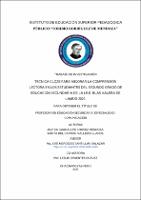| dc.contributor.advisor | Santillan Salazar, José Mercedes | es_PE |
| dc.contributor.author | Chávez Mendoza, Jelitza Guadalupe | es_PE |
| dc.contributor.author | Vallejos Llanos, Sarita del Carmen | es_PE |
| dc.date.accessioned | 2025-08-04T17:57:23Z | |
| dc.date.available | 2025-08-04T17:57:23Z | |
| dc.date.issued | 2023-12-29 | |
| dc.identifier.uri | http://hdl.handle.net/123456789/70 | |
| dc.description.abstract | Following research projet was to demonstrate that the use of the Cloze
technique helps to improve the level of reading comprehension in students of the
second grade of secondary education of the I.E.E “Blas Valera” by Lámud. The type
of research was quantitative, with a descriptive level and pre-experimental design, with
a population of 48 students and a sample of 24 students, in which they improved
significantly since when applying the pre-test it could be seen that of the 24 students,
20 were at the beginning level 2 in process and 2 in achievement, that is, the vast
majority of students did not understand what they read, and after having applied the
Cloze technique through 20 sessions, in the results of the post-test it could be seen that
17 students Of the 24 are between the process level, achieved and outstanding and only
7 remained at the beginning level, conclusively, the Cloze technique is effective and
helps to better understand texts. | es_PE |
| dc.description.tableofcontents | PÁGINA DE JURADOS Y ASESOR.... ........………………………………………ii
RESUMEN..................................................................................................................iii
ABSTRACT................................................................................................................iv
DEDICATORIA...........................................................................................................v
AGRADECIMIENTO.................................................................................................vi
ÍNDICE DE TABLAS...................................................................................................x
ÍNDICE DE FIGURAS................................................................................................xi
INTRODUCCIÓN ....................................................................................................... 1
CAPÍTULO I 1
1. PROBLEMA DE INVESTIGACIÓN..................................................................... 2
1.1. DEL PROBLEMA.................................................................................................................... 2
1.2. FORMULACIÓN DEL PROBLEMA........................................................................................ 4
1.2.1.Problema principal....................................................................................... 4
1.2.2.Problemas específicos.................................................................................. 4
1.3. OBJETIVOS DE LA INVESTIGACIÓN .................................................................................. 4
1.3.1.Objetivo general .......................................................................................... 4
1.3.2.Objetivos específicos................................................................................... 4
1.4. FORMULACIÓN DE LAS HIPÓTESIS ................................................................................... 5
1.4.1.Hipótesis general ......................................................................................... 5
1.4.2.Hipótesis específicas.................................................................................... 5
1.5. JUSTIFICACIÓN DE LA INVESTIGACIÓN ........................................................................... 5
1.5.1.Teórica......................................................................................................... 5
1.5.2.Metodológica ............................................................................................... 5
1.5.3.Práctica. ....................................................................................................... 6
CAPITULO II
2. MARCO TEÓRICO................................................................................................ 7
2.1. ANTECEDENTES DE LA INVESTIGACIÓN ......................................................................... 7
2.1.1.Antecedentes internacionales ...................................................................... 7
2.1.2.Antecedentes nacionales.............................................................................. 8
2.1.3.Antecedentes Regionales............................................................................. 8
2.2. BASES TEÓRICAS.................................................................................................................. 9
2.2.1.Técnica Cloze. ............................................................................................. 9
2.2.2.Teorías que sustentan la técnica Cloze. ..................................................... 12
2.2.3.Comprensión lectora.................................................................................. 12
2.2.3.1.Enfoques de comprensión lectora. .......................................................... 13
2.2.3.2.Niveles de comprensión lectora.............................................................. 13
2.2.4.Teorías que sustentan la comprensión lectora ........................................... 14
2.3. DEFINICIÓN DE TÉRMINOS BÁSICOS.............................................................................. 14
CAPITULO III
3. METODOLOGÍA DE LA INVESTIGACIÓN..................................................... 16
3.1. IDENTIFICACIÓN DE LAS VARIABLES DE INVESTIGACIÓN ........................................ 16
3.1.1.Variable independiente: Técnica Cloze..................................................... 16
3.1.2.Variable dependiente: Comprensión lectora.............................................. 16
3.2. POBLACIÓN Y MUESTRA................................................................................................... 16
3.2.1.Población. .................................................................................................. 16
3.2.2.Muestra. ..................................................................................................... 17
3.3. TIPO, NIVEL Y DISEÑO DE LA INVESTIGACIÓN ............................................................ 17
3.3.1.Tipos de investigación............................................................................... 17
3.3.2.Nivel de investigación ............................................................................... 17
3.3.3.Diseño de investigación............................................................................. 18
3.4. TÉCNICAS E INSTRUMENTOS DE RECOLECCIÓN DE DATOS. ..................................... 18
3.4.1.Técnicas..................................................................................................... 18
3.4.2.Instrumentos. ............................................................................................. 19
3.5. PROCESO DE PRUEBA DE HIPÓTESIS Y ANÁLISIS DE DATOS..................................... 19
CAPITULO IV
4. DESCRIPCIÓN DE RESULTADOS ................................................................... 21
4.1. RESULTADOS ...................................................................................................................... 21
4.1.1.Análisis de la prueba de entrada del grupo experimental (Pre test) .......... 21
4.1.2.Análisis de la prueba de salida del grupo muestral (Pos test). .................. 27
V. CAPÍTULO ........................................................................................................... 30
5. DISCUSIÓN, CONCLUSIONES Y SUGERENCIAS......................................... 31
5.1. DISCUSIÓN. ...................................................................................................................... 31
5.2. CONCLUSIONES. .......................................................................................................... 33
5.3. RECOMENDACIONES................................................................................................ 34
REFERENCIAS.............................................................................................................................. 35
ANEXOS .…………………………………………………………………………..37
ÍNDICE DE TABLAS
TABLA 1:Distribución de la población de la IEE “Blas Valera”…..…………..…..17
TABLA 2:Distribución de la muestra de la IEE “Blas Valera”..……….…………..17
TABLA 3:Medidas de tendencia central................................................................ 21
TABLA 4:Frecuencia obtenidos del Pre test. ........................................................ 21
TABLA 5:Nivel de comprensión lectora de los estudiantes. .................................... 22
TABLA 6:Nivel de comprensión lectora en la dimensión literal………….............. 23
TABLA 7: Nivel de comprensión lectora en la dimensión inferencial…................. 24
TABLA 8:Nivel de comprensión lectora en la dimensión crítico.………………….26
TABLA 9:Medidas de tendencia central................................................................... 27
TABLA 10:Tabla de frecuencia obtenidos del pos test............................................. 27
TABLA 11:Nivel de logro de los estudiantes. .......................................................... 28
TABLA 12:Resultado general del Pre test y Pos test................................................ 29 | es_PE |
| dc.format | application/pdf | es_PE |
| dc.language.iso | spa | es_PE |
| dc.relation | TÉCNICA CLOZE PARA MEJORAR LA COMPRENSIÓN LECTORA EN LOS ESTUDIANTES DEL SEGUNDO GRADO DE EDUCACIÓN SECUNDARIA DE LA I.E.E. BLAS VALERA DE LAMUD-2023. | es_PE |
| dc.relation.uri | Investigación | es_PE |
| dc.rights | info:eu-repo/semantics/openAccess | es_PE |
| dc.subject | Investigación | es_PE |
| dc.title | TÉCNICA CLOZE PARA MEJORAR LA COMPRENSIÓN LECTORA EN LOS ESTUDIANTES DEL SEGUNDO GRADO DE EDUCACIÓN SECUNDARIA DE LA I.E.E. BLAS VALERA DE LAMUD-2023. | es_PE |
| dc.type | info:eu-repo/semantics/bachelorThesis | es_PE |
| dc.type.version | info:eu-repo/semantics/publishedVersion | es_PE |
| dc.publisher.country | PE | es_PE |
| dc.subject.ocde | https://purl.org/pe-repo/ocde/ford#5.03.00 | es_PE |
| renati.author.dni | 73665335 | |
| renati.author.dni | 44056932 | |
| renati.advisor.orcid | https://orcid.org/0009-0006-5615-9565 | es_PE |
| renati.advisor.dni | 33403719 | |
| renati.type | https://purl.org/pe-repo/renati/type#trabajoDeInvestigacion | es_PE |
| renati.level | https://purl.org/pe-repo/renati/nivel#tituloProfesional | es_PE |
| renati.juror | P: Castañeda Quiliche, Julio Cesar | es_PE |
| renati.juror | S: Flores Oyarce, Juan Carlos | es_PE |
| renati.juror | V: Sifuentes Chávez, Leslie | es_PE |
| thesis.degree.name | Profesor/a de Comunicación | es_PE |
| thesis.degree.grantor | Instituto de Educación Superior Público Pedagógico "Toribio Rodríguez de Mendoza" | es_PE |
| thesis.degree.discipline | Educación Secundaria, Especialidad: Comunicación. | es_PE |



